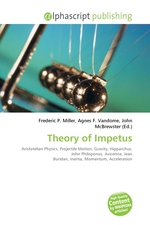Theory of Impetus
Frederic P. Miller, Agnes F. Vandome, John McBrewster
бумажная книга
High Quality Content by WIKIPEDIA articles! The theory of impetus was an auxiliary or secondary theory of Aristotelian dynamics, put forth initially to explain projectile motion against gravity. It was first introduced by Hipparchus in antiquity, and subsequently further developed by John Philoponus in the 6th century AD. A radically different version was later developed by Avicenna (11th century) and Jean Buridan (14th century), which became an ancestor to the concepts of inertia, momentum and acceleration in classical mechanics. In the 6th century, John Philoponus partly accepted Aristotle's theory that "continuation of motion depends on continued action of a force," but modified it to include his idea that the hurled body acquires a motive power or inclination for forced movement from the agent producing the initial motion and that this power secures the continuation of such motion.
Данное издание не является оригинальным. Книга печатается по технологии принт-он-деманд после получения заказа.


